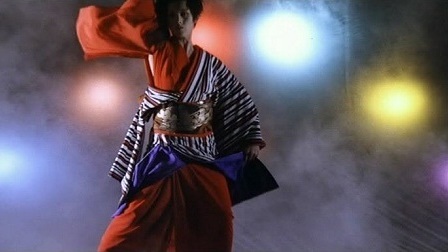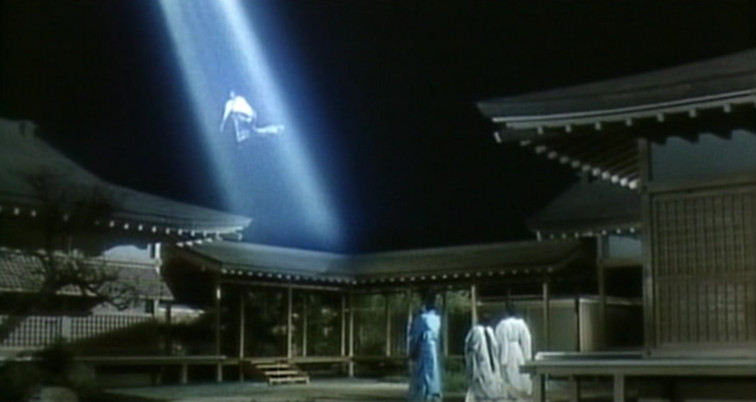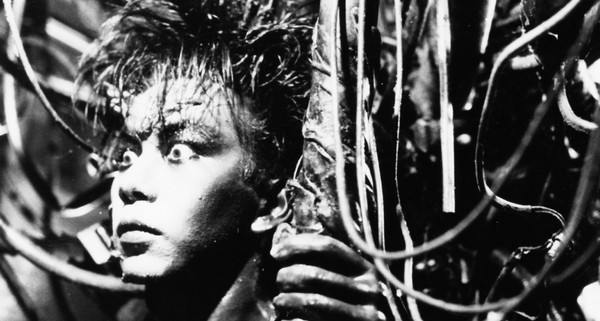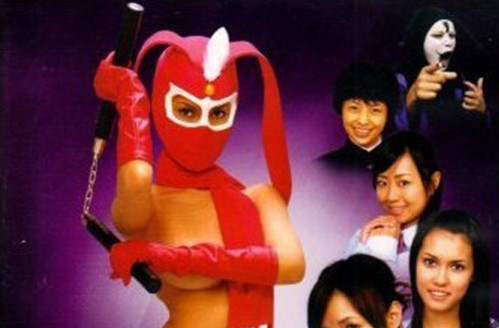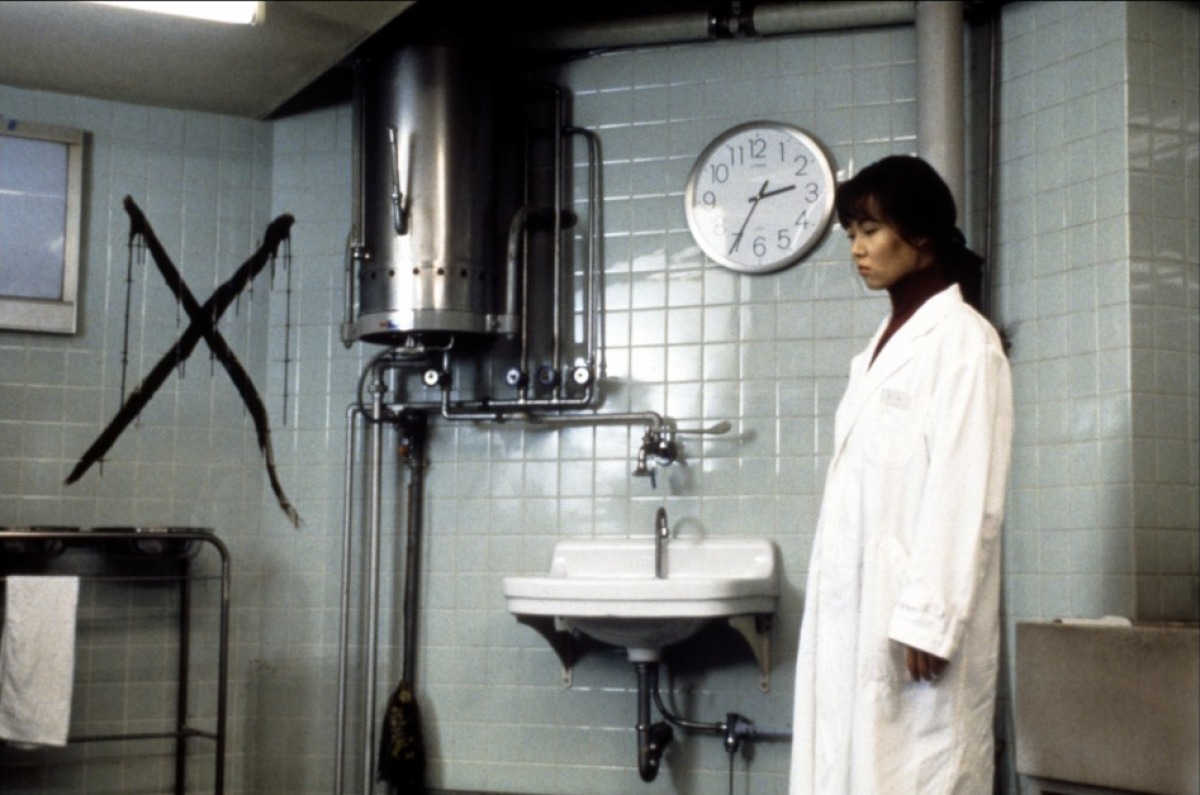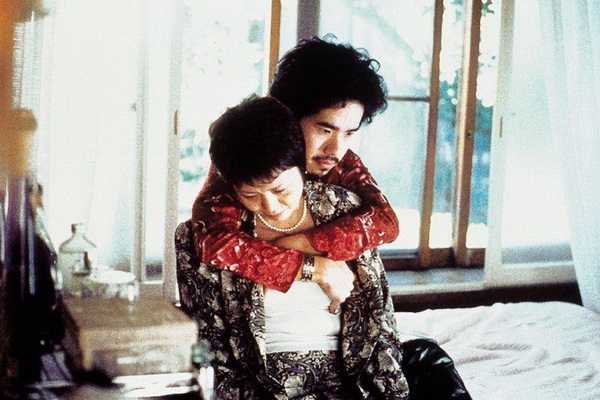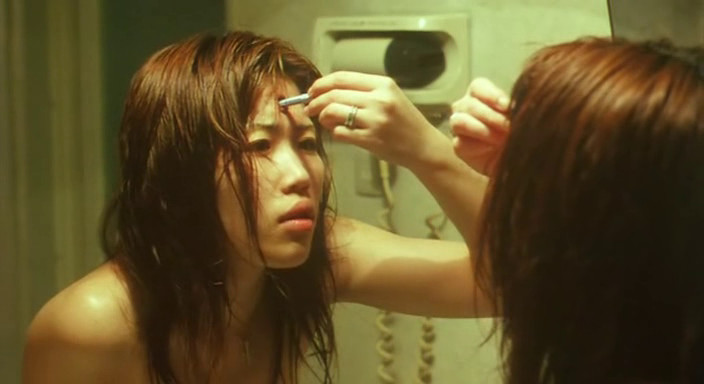11. Death Shadows by Hideo Gosha (1986, Shochiku)
Death Shadows was Hideo Gosha’s final return to the jidai-geki genre which initially made him famous after a prolific period working in the gangster and modern crime genres throughout most of the 1970’s. The intriguing aspect that sets Death Shadows apart from Gosha’s other jidai-geki films is the fact that the movie takes place during no specific time period or setting, borrowing elements from modern times and various eras of Japanese history to make a yakuza thriller based without a specific time period.
This impressionistic style borrows from everything from German expressionism to French poetic realism as the camera sweeps throughout an almost mythical landscape of Japans history spanning anachronistic elements borrowed throughout not only history but cinema itself.
12. Princess From the Moon by Kon Ichikawa (1987, Toho)
Based on a traditional Japanese folklore (with some elements changed liberally), Kon Ichikawa’s fantastical Princess From the Moon is a story that brings together traditional Japanese setting, morals, and theology with fantastical tales of extraterrestrials to create a story steeped in allegory about the relation between old and new Japan as well as their continuing friendship with the west.
Starring the great Toshiro Mifune in one of his later roles, the story of two hard working peasants who one day find a young girl has mysteriously appeared at their deceased daughters grave and raise the child. As the child Kaya (Yasuko Sawaguchi) grows at an alarming rate she thwarts off the advances of the villages men and ends up returning to space via an orbital spaceship that appears at the end of the film. Princess was released as Toho’s 55th anniversary film and one of Ichikawa’s only fantasy genre pieces.
13. Tetsuo, the Iron Man by Shin’ya Tsukamoto (1989, JHV)
Tetsuo, the Iron Man is Shin’ya Tsukamoto’s most infamous film, and the one that put him on the international map. The story of the Metal Fetishist being hit by a car driven by a businessman (who eventually becomes the Iron Man) played by Tomorowo Taguchi and his girlfriend (Kei Fujiwara) after running out into the street, then discarded into a ravine by the couple is a grotesque and engaging story of the transformation of society and seen through the guise of physical transformation.
The Metal Fetishist inhabits the businessman after his seeming death and transforms his body into a metal forms complete with giant iron drill penis used to impale his girlfriend. The metamorphosis of mind and body is seen as a representation of modern capitalist society and its molding of young men and women into machines of society and morality that juxtapose creation and thought.
14. Kekko’s Mask by Hikari Hayakawa (1991, JHV)
Hikari Hayakawa’s Kekko Mask was the first live-action transposition of the manga series following the title character Kekko Kamen and a prime example of the cult sensibilities of the pink film as the title character protects the young girls of the Spartan School against its ruthless male teachers and directors by stunning them with her private parts and then proceeding to beat them up. Kekko wears a red mask, cape, boots, and nothing else as she fights for the rights and protection of young females in the nude.
Rather than being objectified by her female form she uses it as her main weapon against those suppressing her in order to save the young girls of the school from continual abuse. Released by Japan Home Video the film is a crossover of pink films with exploitation pieces in the vein of many other Japanese films in similar veins by utilizing a strong female lead to redeem not only themselves but other against a male dominated patriarchal modern Japan.
15. Cure by Kiyoshi Kurosawa (1997, Daiei)
Kiyoshi Kurosawa’s 1997 film Cure stands out from many of the films on this list in the fact that it is a truly grisly horror story with gritty tonal qualities and straightforward crime thriller aesthetics that would become commonplace in East Asian cinema throughout the 90’s and 2000’s. Detective Takabe (Koji Yakusho) is investigating a slew of murder where the victims are killed by having an X carved into their necks and the perpetrators are found nearby but can’t remember the killing.
Finally a young man Mamiya is found near the scene of one of the crimes and is discovered to be a master of psychology who is implanting thoughts into peoples minds. As the story unfolds the intentions become more diluted as the lines between reality and impairment become blurred and the audiences own interpretations of invents become more real than the events themselves.
16. Versus by Ryuhei Kitamura (2000, KSS)
Ryuhei Kitamura’s 2000 action epic Versus was first introduced to me as “a two hour class in how to film extreme stylized violence” and years later that is still the best summation I can think of for this film. As escaped convict Prisoner KSC2-303 fights off everyone from yakuza thugs to demonic and zombie-like creatures at the 666th portal to another dimension in the forests of Japan, the violence never stops and becomes increasingly more extreme and stylized as various styles of martial arts, bad acting, and weapons enter the picture.
By steeping the film in a mythos of otherworldly connotations and creatures directly tied into the local yakuza boss being a vampire who brings about the undead, the film is a true exercise in entertainment and genre filmmaking that doesn’t let down or let up for one minute.
17. Visitor Q by Takashi Miike (2001, CineRocket)
Made as the final part of the six-part Love Cinema series by CineRocket, Takashi Miike’s Visitor Q is a low budget bitingly black comedy about a severely dysfunctional family who finally falls apart when a mysterious young man (Kazushi Watanabi) enters their lives, not dissimilar from the basic plot elements of Pier Paolo Pasolini’s Teorema.
As the father pays to sleep with his prostitute daughter to the son being picked on by school bullies and mercilessly taking out his frustrations on his heroin addicted mother, the absurdist portrayal of this family in disarray is given a shock by the strange Visitor Q who embraces and utilizes their moral downfalls to further himself and make them examine their own realities.
The film is notable for its use of the then budding digital camera technology which allowed for minimal lighting and less controlled shooting conditions to create a darkly humorous film that juxtaposes its content with a realistic aesthetic.
18. The Glamorous Life of Sachiko Hanai by Mitsuru Meike (2003, Shintoho)
Mitsuru Meike’s The Glamorous Life of Sachiko Hanai is interesting in that it was originally developed and pitched as a pink film that then was allowed by Shintoho to be evolved into a feature length narrative that utilized linear storytelling aspects as well as dynamic character development. The film stars the famous pink film actress Emi Kuroda in its title role who gets shot in the head after recording a gun fight between a North Korean and a Middle Eastern man.
The bullet gives her superior mental powers that helped her to solve a crisis that could end the world, nuclear war. In one particular scene, Sachiko comes into possession of an exact replica of George W Bush’s finger which then becomes animated and could spell the end of the world. The clashing of political ideologies and regimes creates a view of Japan saving the world from nuclear holocaust.
19. L’amant by Ryuichi Hiroki (2004, Arcimboldo YK)
Ryuichi Hiroki’s career started in the pink film industry, becoming prolific in his output within the genre. The director then started to make complex personal dramas revolving around the power of sexuality and morality within Japanese society. 2004’s L’amant is about a 17 year old school girl Chikako who signs a one year sex contract with three middle aged men who only go by A, B, and C (with A being played by the star of Tetsuo, the Iron Man, Tomorowo Taguchi), to be null in void on her 18th birthday.
The films careful treatment of sex and the exploration of the young girls relationship that builds with her three suitors explores a side of society often not traversed on screen.
20. Love Exposure by Sion Sono (2008, Omega Project)
Sion Sono’s 4 hour epic exploring the culture of upskirt photography and the effect of strict catholic morality on the youth of Japan follows Yu (Takahiro Nishijima) as he sets out to commit sins in order to properly confess to his father Tetsu, a priest.
As a devout catholic Yu believes he has hardly sinned so he seeks out acts and people who can help him to commit sins in order to confess and fulfill what Yu sees as a pivotal part of his religion. As Yu traverses the landscape of upskirt photography and youth culture in modern urban Japan he becomes easily susceptible to influence and even others views on his own morality. The film is the first (and longest) part of Sono’s Hate trilogy.
Author Bio: Ian Cahoon is a Film Studies student at Towson University who is actively involved in the Baltimore film community. He sometimes updates his blog http://ianlcahoon.wordpress.com but wishes to start updating it more.
